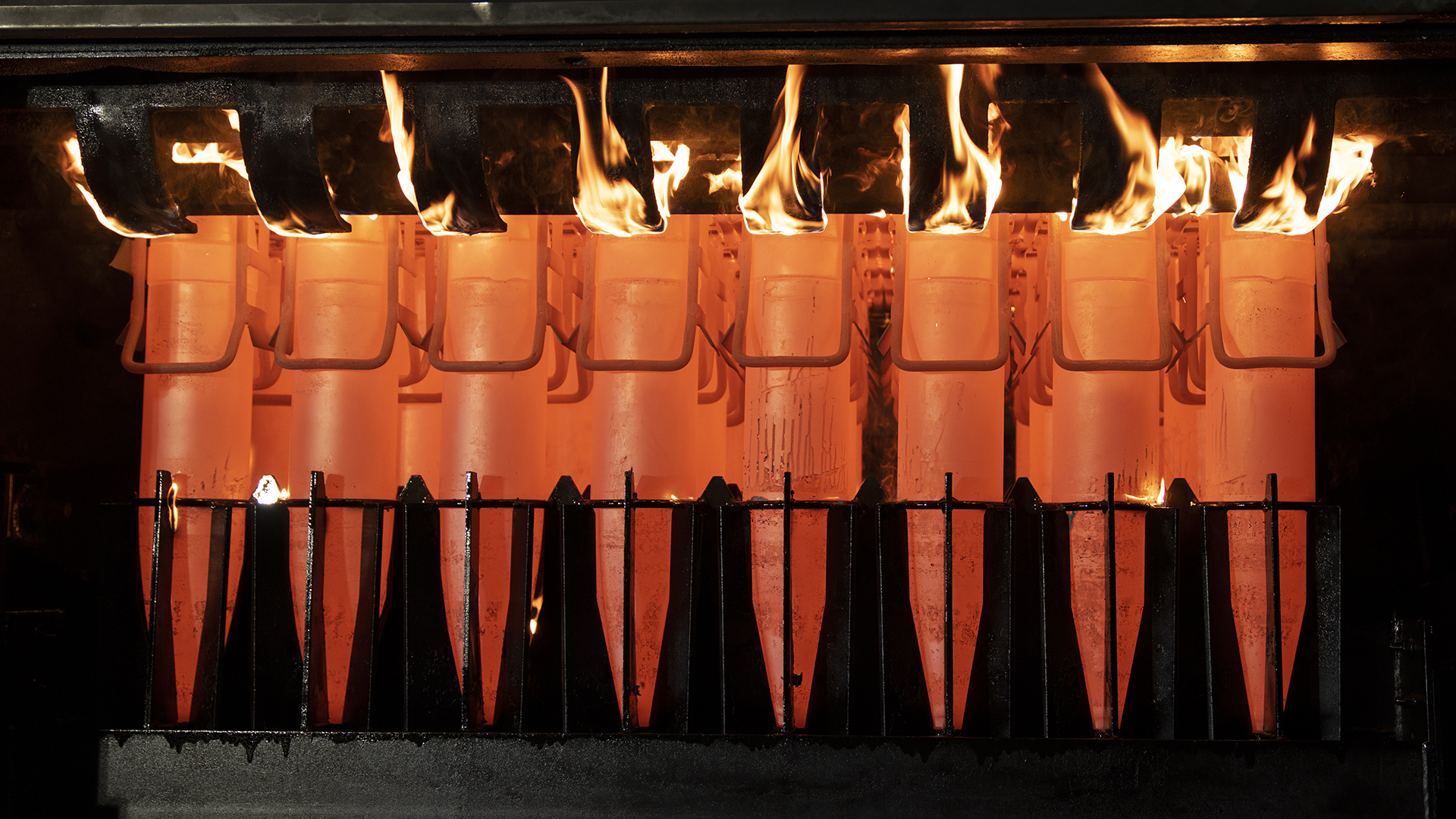Even after sending more than two million 155mm artillery rounds to Ukraine since February 2022, the Pentagon is “comfortable” in the view that it can continue to supply Kyiv with badly needed heavy ammunition while still meeting U.S. requirements, a spokesman told reporters on Thursday. To help meet both countries’ demands, the plan is to increase the monthly production of these shells more than threefold by the end of next year.
The United States has dramatically ramped up artillery shell production capacity since the start of Russia’s full-on invasion of Ukraine, Air Force Brig. Gen. Pat Ryder, the Pentagon’s top spokesman, told reporters, including from The War Zone, Thursday. Production of 155mm artillery rounds went from 14,000 a month in February of 2022 to approximately 24,000 a month now, he said, adding that plans call for even greater increases.
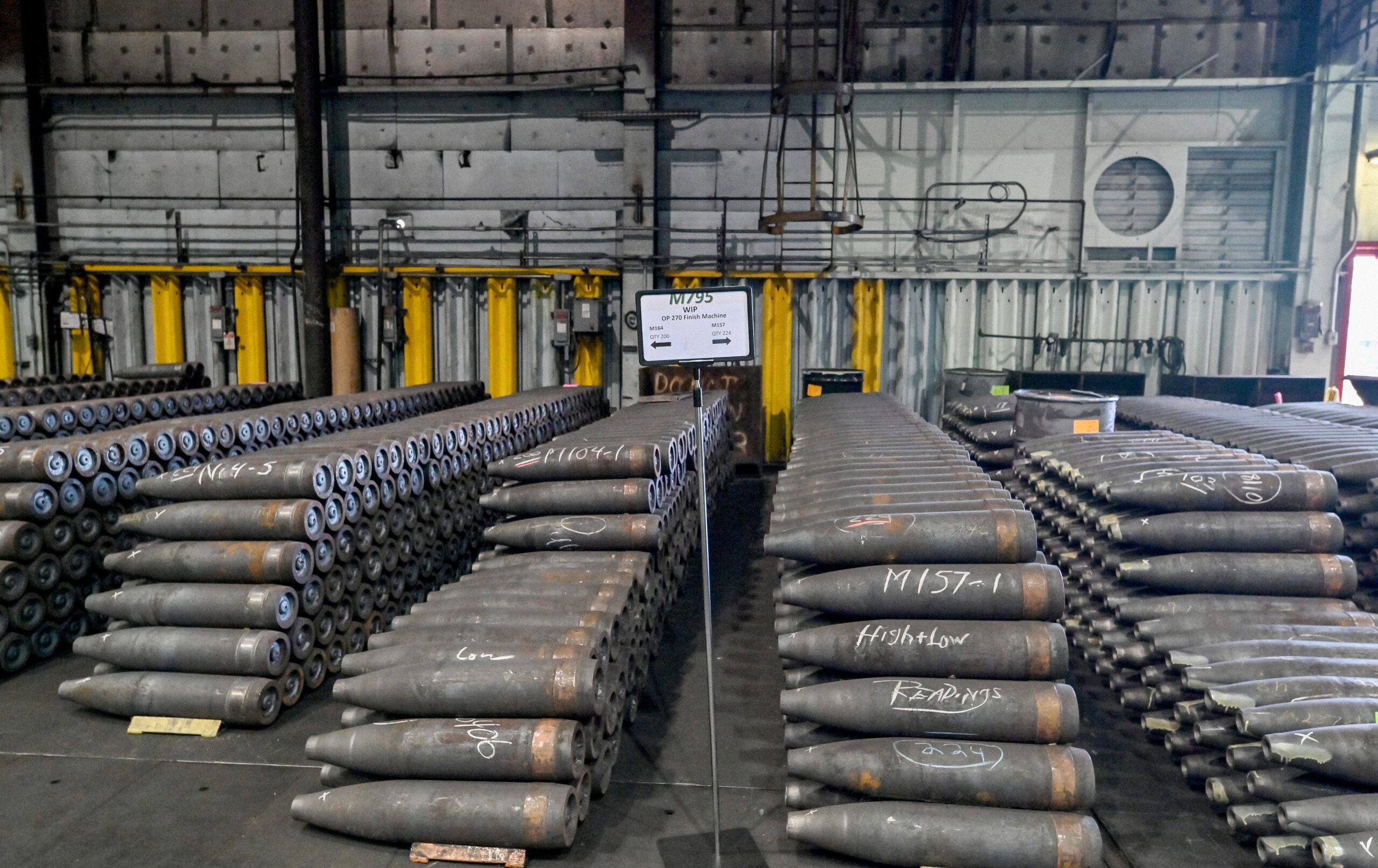
“Currently, we plan to be at over 80,000 [155mm artillery shells] a month over the following year,” he said.
While these stockpiles “are not unlimited, we are comfortable where we’re at right now with our stockpiles and we are comfortable that we will be able to continue to work closely with allies and partners around the world on that front,” said Ryder.
In April, Ukrainian parliamentary member Oleksandra Ustinova told the AP that the country’s armed forces were firing between 6,000 and 8,000 155mm shells every day.
While the U.S. goal now is to produce between 80,000 and 85,000 shells per month by Fiscal Year 2025, challenges exist to reach that objective, a top Army official told reporters earlier this week.
“We are having to establish entirely new production lines, for the metal parts, the actual shells themselves,” said Doug Bush, assistant secretary of the Army for acquisition, logistics, and technology.
The Army is also investing in “load, assemble and pack capacity, which is filling the shells with explosives, so they now become a functional weapon,” he said. “That capacity expansion is also underway at at least two locations.”
The final piece, he said, “is bringing in additional production either overseas or domestically, for the propellant that actually shoots [the shells] out of the cannon.”
“So all of those things do have to come together,” he said. “There are always risks in that. But I think we’re getting the resources, getting on contract, and just working really closely every day with our industry partners, trying to help them knock down barriers to get there.”
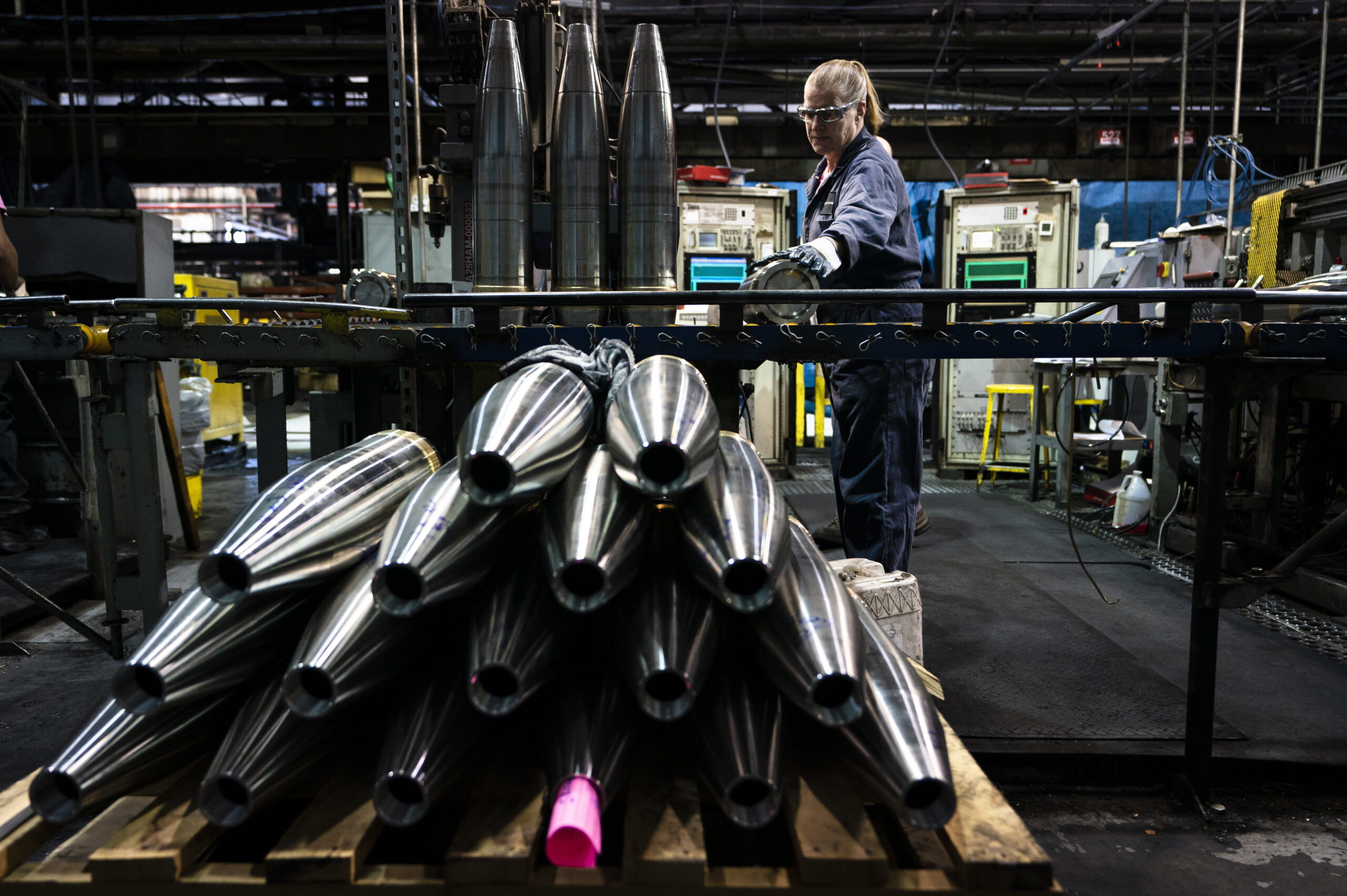
When it comes to supplying Ukraine, the United States is getting help from its international partners, Bush noted.
“We’re working through our allies to help make sure Ukraine is supplied,” he said. “So it’s not all the United States. And I think that’s a success story. You know, the United States is the arsenal of democracy, but we can have multiple arsenals in other democracies, and we have those and they’re helping.”
In March, European Union members announced their own plan to send one million 155mm artillery shells to Ukraine over the next year. Ukraine has been receiving artillery ammunition of various types from other countries around the world, too.
Those deliveries have included a number of different types of 155mm shells. This includes ones from the United States loaded with controversial cluster munitions known as Dual-Purpose Improved Conventional Munitions (DPICMs), as you can read more about here.
Ukrainian officials had been actively asking for these rounds, which have given them another tool for uprooting dug-in Russian forces occupying vast trench networks and for engaging large enemy formations in open terrain. U.S. officials have also cited stocks of DPICM rounds as just being a ready supply of badly need additional shells for Ukraine.

Ryder was asked on Thursday whether the DPICMs were seen as a “bridge” through 2025 to supply Ukraine while at the same time maintaining U.S. stocks as it ramps up production.
DPICMs, he said, were provided to Ukraine to give its troops “the capability to continue to take the fight to the enemy. We have all indications that they’re employing those weapons properly on the battlefield, as they indicated they would. But 155mm [rounds] aside, whatever they need, we’re going to continue to work closely to ensure that they have what’s necessary to continue to fight and to take back some territory.”
Critics have warned that the individual submunitions in DPICM shells have historically had high failure rates and that unexploded ones could pose hazards to friendly forces and civilians. Ukraine has already provided the Pentagon with a report about the use of controversial American cluster munitions in the fight with Russia, a Ukrainian official told CNN on Wednesday.
“The official said the information transmitted to the Defense Department included both the number of rounds fired and the number of Russian targets destroyed, though the official declined to say what those figures are,” CNN reported.
Given the challenges facing both Ukraine on the battlefield and the ability of the U.S. and allies to supply enough ammo for Kyiv and themselves, this is a situation we will continue to monitor closely and update when warranted.
Before we head into the latest news from Ukraine, The War Zone readers can catch up on our previous rolling coverage here.
The Latest
On the battlefield, Ukraine says it is holding Russian forces back in their offensive toward Kupiansk in Kharkiv Oblast and making small gains in its counter-offensive. The Russian Defense Ministry said its troops are “improving the situation” near Kupiansk and holding back the Ukrainian advance elsewhere.
“The situation in the east is difficult, but the enemy is unable to achieve their goals,” Ukrainian Deputy Defense Minister Hanna Maliar said Thursday on her Telegram channel. “Defense forces are effectively restraining the advance of Russian troops in the Kupiansk and Lyman directions.”
Meanwhile, the counteroffensive continues in the Melitopol and Berdiansk directions, she said.
“Despite extremely difficult combat conditions and enemy resistance, our troops have partial success in the direction of Urozayne, further south and south-eastern Staromayorske,” said Maliar.
The Russian Defense Ministry (MoD) has made competing claims.
“In the Kupiansk direction, in the course of conducting offensive operations, assault detachments of the Zapad Group of Forces improved the situation along the front line,” according to a post on the Russian MoD Telegram channel Thursday.
Counterattacks by Ukraine have been repelled close to Novosyolovskoye in Luhansk Oblast and Sinkovka and Mankovka in Kharkiv Oblast, the Russian MoD also claimed.
In Zaporizhzhia Oblast, “as a result of actions by units of the Russian grouping of troops, aviation and artillery, a counterattack of the 46th Airmobile Brigade of the [Armed Forces of Ukraine has been repelled near Uspenovka,” the Russian MoD said.
Yesterday, we told you that officials in Kupiansk were preparing to order a mandatory evacuation of about 11,000 residents as Russian forces pressed closer to that Kharkiv Oblast city and increased firing on it.
Today, Kupiansk District Military Administration Andrii Kanashevich disclosed via his Telegram channel that the order had been signed yesterday in the end and was now in effect.
“Mandatory evacuation has been announced for the residents of the city of Kupyansk, Zaoskilya (left bank of the Oskil River) [and] in the territory of the Kupyansk territorial community. Kivsharivka, Kupyansk – Vuzlovy,” he said.
With Ukraine’s counteroffensive going slower than many had hoped, President Joe Biden on Thursday asked Congress for an additional $20.6 billion for Kyiv, The Washington Post reported.
The White House Office of Management and Budget wrote a letter to lawmakers seeking $13 billion in new military aid and $8.5 billion in additional economic, humanitarian, and security assistance funds for Ukraine and other countries affected by the war, the paper reported. The funding request also includes other forms of assistance for Ukraine.
It’s part of a total $40 billion ask that includes more than $12 billion for disaster relief and other emergency domestic funds, including hurricanes, as well as tens of millions of dollars to boost pay for firefighters on the front lines of the wildfires that have hit many parts of the country.
The Post did not specify exactly what military aid will be included in the request, which still has to clear a contentious Congressional debate.
Ryder, the Pentagon spokesman, declined to comment Thursday on any supplemental aid package for Ukraine, but said that there is still about $6.2 billion in Presidential Drawdown Authority (PDA) funding available beyond the end of the current fiscal year on Sept. 30 as the result of an accounting revaluation. PDA is a mechanism through which weapons and other materiel currently in U.S. stocks can be transferred to other countries like Ukraine. Ryder said there is an additional $600 million in Ukraine Security Assistance Initiative (USAI) funding – a funding stream to support the procurement of new materiel – available as well.
“The bottom line and all of that is we will continue to work very, very closely with the interagency and with Ukraine to ensure they get what they need,” he said.
Despite sanctions imposed on Russia to cripple its weapons production capability, Moscow appears to have begun making copies of attack drones it acquired from Iran last year and is using them in combat against Ukrainian forces, The New York Times reported Thursday.
The publication cited a report issued Thursday by Conflict Armament Research, an independent group based in Britain that identifies and tracks weapons and ammunition used in wars. It is the group’s 10th published account of its work in Kyiv, where researchers have analyzed Russian military hardware collected on the battlefield by Ukraine’s security services.
The researchers traveled to Kyiv in late July and inspected the wreckage of two attack drones that were used in combat in southeastern Ukraine, the Times reported. Both appeared to be Iranian Shahed-136s, but they contained electronic modules that match components previously recovered from Russian surveillance drones, according to the report.
The materials used to build the two drones and the internal structure of their fuselages also differed greatly from those known to have been made in Iran, the researchers said.
“This new version will allow Russia to sustain its attack patterns and its reliance on these one-way drones,” said Damien Spleeters, who led Conflict Armament Research’s investigation. “So the fact that they make it domestically will allow them to continue to rely on it.”
Ukraine announced a new “humanitarian corridor” in the Black Sea on Thursday to release cargo ships trapped in its ports since the outbreak of the full-on war, Reuters reported Thursday. It’s a new test of Russia’s de facto blockade since Moscow last month abandoned the Black Sea Grain Initiative, hammered out last year to allow grain and other food and fertilizer to be shipped out via Ukraine’s Black Sea ports of Odesa, Chornomorsk, and Yuzhny.
These routes will primarily be used for civilian vessels that have been stuck in Ukrainian ports of Chernomorsk, Odesa and Pivdenny since the beginning of the full-scale invasion of Russia, according to the Ukrainian Armed Forces General staff.
In a statement on its Facebook page, the Ukrainian Armed Forces General Staff said the routes had already been proposed by Ukraine directly to the International Maritime Organization (IMO).
“Vessels whose owners/captains officially confirm readiness to sail in current conditions will be allowed to pass through routes,” the General Staff stated.
“The corridor will be very transparent, we will put cameras on the ships and there will be a broadcast to show that this is purely a humanitarian mission and has no military purpose,” Oleh Chalyk, a spokesperson for Ukraine’s navy, told Reuters.
The Black Sea region has become especially volatile of late. After a Ukrainian uncrewed surface vessel attack (USV) on the Kerch Bridge last month, Russia began bombarding ports in and around Odesa and later Ukrainian ports on the Danube River, bordering NATO member Romania.
Ukraine, meanwhile, ramped up its USV attacks on Russian shipping, severely damaging the Russian Navy landing ship Olenegorsky Gornyak and the Sig, a Russian commercial chemical/oil tanker. You can read more about that in our story here.
Speaking of the Olenegorsky Gornyak, a new photo emerged of the vessel in a floating dock at the Novorossiysk Shipyard earlier this month, where it was towed after being hit by the Ukrainian USV.
Highlighting its increasing use of USVs more directly, Ukraine’s Defense of Ministry Tweeted out art depicting the “feeding Ukrainian naval drones with Russian ships.”
Images have emerged on social media of a major fire near Odintsovo. This is a town just west of Moscow near an airport that saw its airspace restricted earlier Thursday, possibly over concerns about another attempted Ukrainian drone attack on Moscow. You can read more about that a little later in this story.
The Russian Baza media outlet is reporting that a beer warehouse on Zelenaya Street in Odintsovo is on fire, but The War Zone has not been able to confirm whether or not that is the case.
“The area of the fire was 2800 square meters,” according to Baza. “Roofs and ceilings collapsed throughout the area.”
So far, there is no indication one way or the other about the cause of the blaze or if there are any connections to any other incidents nearby earlier today.
The Odintsovo fire follows other incidents in the same general area reported around 24 hours earlier.
Airspace over two major airports near Moscow was temporarily closed Thursday, Russian authorities and media reported. While Russia’s Federal Air Transport Agency (FATA) did not provide a specific reason, several Russian media outlets and Telegram channels claimed it was out of concern that the capital area was under yet another Ukrainian drone attack. If true, this would have been the third one in just a few weeks.
“This morning, August 10, 2023, during the period of temporary restriction on the reception and departure of flights from Vnukovo and Domodedovo airports, aircraft crews, air traffic controllers and airport ground services took all necessary measures to ensure flight safety,” was what FATA had to say on its Telegram channel. About a half dozen aircraft were rerouted, the agency said.
Meanwhile, on the ground near Domodedovo, one of the airports that had been closed, a huge fire broke out reportedly at an automobile repair shop that sent flames in the air visible for miles. The auto repair shop fire engulfed about 1,000 square meters and took place about six miles from the Domodedovo airport, Russia’s Ministry of Emergency Situations said, according to several media outlets.
Russian officials have no yet made any statements about the cause of the fire, which reportedly resulted in no injuries. However, there were differing witness accounts reported by Russian media and Telegram channels.
The Russian SOTA media outlet reported on its Telegram channel that its source at the scene “claims that the explosions that eyewitnesses heard occurred after the start of combustion, and the fire itself started from the metal receiving point.”
The fire then spread to a building housing a furniture shop and a car dismantling shop, where decommissioned buses are parked, according to that account.
“The explosions began when the fire got close to the gas cylinders,” SOTA reported, adding that it could not independently verify the account.
Meanwhile, the Astra and the VChK-OGPU Telegram channel described the events differently.
“Residents of Domodedovo report that they heard two explosions, then a fire started,” Astra reported. “According to them, the area around the boiler house is on fire.”
“Eyewitnesses say that there were two pops, then an explosion in the area of the industrial zone and smoke poured out,” VChK-OGPU reported. “It is possible that the UAVs were shot down.”
Some Russian Telegram channels are speculating, without evidence, that the blaze may have been sparked by a downed drone. There is no confirmation of that and what, if any connection between any of these events, remains unverified.
The Russian Defense Ministry (MoD) on Thursday did claim that there were several drones downed over its territory and Ukraine’s Crimean Peninsula, which it occupies.
“Last night attempts by the Kyiv regime to carry out terrorist attacks by unmanned aerial vehicles were foiled over the territory of Kaluga and Moscow regions, as well as Sevastopol [in Crimea],” the Russian MoD announced on its Telegram channel.
The MoD reported that “two UAVs moving forward Moscow were destroyed in the sky by air defense facilities above Maloyaroslavl district of Kaluga region and over the territory of Odintsovo district of Moscow region.”
The Vnukovo airport is located about five miles south of the Odintsovo district and about seven miles west of the Moscow Ring Road. The Domodedovo is located about 12 miles south of the Moscow Ring Road.
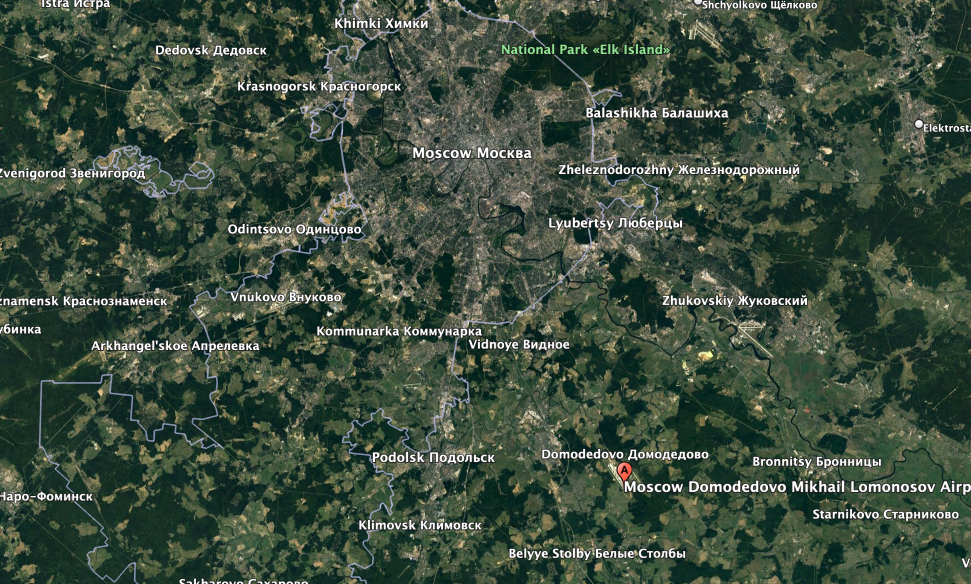
Close to Sevastopol in the occupied Crimean peninsula, “two UAVs were destroyed by air defense facilities on duty, and nine others were suppressed by electronic warfare means and crashed in the waters of the Black Sea without reaching their target,” the Russian MoD reported. “As a result of the foiled terrorist attacks, there were no casualties or damage.”
There were also Ukrainian drone attacks outside of the Moscow area, according to the Russian MoD.
It is not fully clear at this point whether the drone attacks near Moscow referred to by the Russian MoD Thursday were the same ones that the city’s mayor reported Wednesday. You can read more about that here in our story about a major explosion at a nearby factory that injured dozens. As with Thursday’s fire, that explosion created a plume of smoke visible for miles.
Neither FATA nor the Russian MoD made any connection between these reported attempted drone attacks and the airport closures on Thursday, either. But the Russian Astra and Baza media outlets and the Russian VChK-OGPU Telegram channel report that the closure at the Vnukovo airport west of Moscow was the result of the initiation of the so-called “Carpet Plan,” designed to address potential threats posed by unidentified aircraft or objects, like drones, in the sky.
All of this is occurring in the fog of war and we have no way of verifying these accounts. Even if there were no new drone attack attempts, and no connection between the auto repair shop fire and Ukraine, the various reports and rumors underscore the impacts of previous confirmed ones.
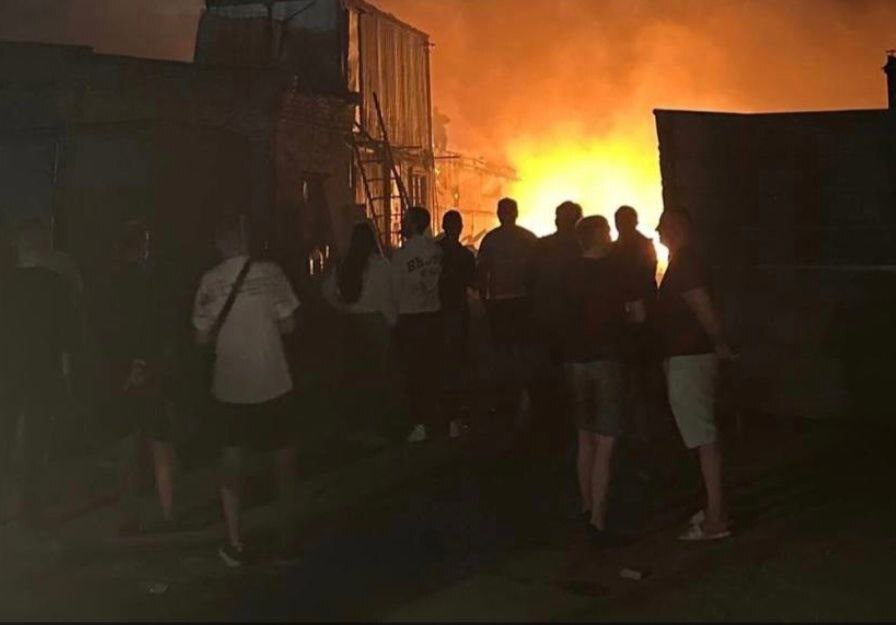
A Russian BTR-MD amphibious armored personnel carrier with some striking artwork has apparently been captured and is now being used by Ukrainian forces, as you can see in this image below. Whether it was captured painted like this or if that was applied afterward is not immediately clear, but there have been previous examples of somewhat similar paintwork on Ukrainian vehicles.
More Pakistani ammunition has appeared in use by Ukrainian forces, in this case 155mm high explosive shells produced this year. You can read more about how Ukraine obtains Pakistani ammunition this past War Zone story.
A Polish-donated PT-91 Twardy tank was recently spotted heading to battle on the frontlines in Zaporizhzhia Oblast. In February, Poland announced it would hand over 60 of those tanks.
Back in May, a Ukrainian drone dropped a 40mm grenade on a Russian MT-LB tracked armored vehicle packed with anti-tank weapons that not only destroyed the vehicle, but it also created a huge crater. Well, it has now being claimed that three months later, a Russian BTR-80 wheeled armored personnel carrier inadvertently found that same hole and accidentally drove into it. It is unclear from the video below, however, how or why that happened.
The Ukraine Weapons Tracker open source intelligence group posted another video of Russian tanks burning after being attacked by Ukraine. It is unclear from the video how the Russian T-72B tanks were attacked.
Ukrainians aren’t the only ones destroying Russian tanks. Russia’s vaunted Airborne troops are seen in this video below destroying one of their own tanks, an apparently abandoned T-72B3.
And finally, the Ukrainian force is with Mark Hamill.
The man who played Luke Skywalker in the Star Wars trilogy is a huge supporter of Ukraine and “ambassador” for President Volodymyr Zelensky’s United24 fundraising operation. Thursday, he received an award for raising more than $1.5 million to purchase 10 reconnaissance drones.
That’s it for now. We’ll provide more information about Ukraine when it becomes available.
Contact the author: howard@thewarzone.com
